Here at Mattress Clarity we put everything, from mattresses to pillows, through a series of tests to help us decide who to recommend the products to, or if a product is worth recommending at all. Mattress toppers are no different. Our testing processes for toppers are similar to how we test mattresses.
We assess each mattress topper for its firmness, how much it changes a mattress’s firmness and feel, how well it works for each sleeping position, and much more. Keep reading to see how we test mattress toppers.
What We Look for While Testing Mattress Toppers
There are a number of categories we look for when we review mattress toppers: cooling, durability, warranty, fit, and firmness adjustment. I’ll talk below about why each factor is so important and how we test for each.
Firmness
Most of the time, people turn to mattress toppers to soften their current mattress. Once we’ve unboxed a mattress topper and let it expand and off-gas, we’ll place it on a mattress and lay on it to start assessing the firmness of the topper. This test usually consists of quickly switching between each sleeping position to get an overall feel for the topper.
We give the mattress toppers the same firmness levels as we give mattresses: soft, medium, or firm. As mentioned, most toppers are intended to soften mattresses, so most of the toppers we’ve tested fall in the soft or medium-firm range. But there are mattress toppers that are intended to be firm.
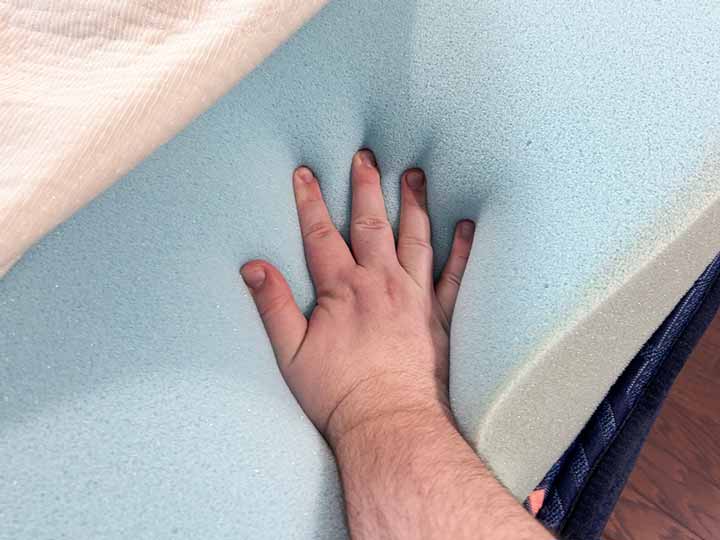
The thickness of a mattress topper will also influence its firmness. In our testing experience, thicker mattress toppers (around 3” to 4”) will feel much softer than those on the thinner side (around 2” tall). The thickness of a topper can also impact how much the topper will adjust the firmness of the mattress as well.
While we don’t score on firmness, the firmness of a mattress topper helps us score the firmness adjustment category.
Firmness Adjustment
Once we’ve assessed the firmness of the mattress topper, we’ll then take into account the firmness of the mattress we’re testing the topper on and see how much the topper changes that firmness level. We rate mattresses on a scale from one to 10, with one being the softest, and 10 being the firmest of firm. A true medium-firm mattress is a 6.5/10, so anything above a 7/10 is what we consider a firm mattress.
Mattress toppers that have a soft firmness level will adjust firmness by about two points. This means if you’ve got an especially firm mattress at around an 8/10, a soft mattress topper can help that mattress feel around a 6/10. Medium-firm mattress toppers will soften mattresses by about one to one and a half points.
Firm mattress toppers will have the opposite effect. If your mattress is too soft, using a firm mattress topper can increase the firmness by about two points, depending on the material.
Firmness is a rather subjective category, but toppers that can provide a significant firmness difference tend to score higher. Some brands will offer a topper in multiple firmness options as well, and toppers with firmness options will often receive high scores because of the variety.
Feel
In addition to changing the firmness of your mattress, a topper can alter the way a bed supports and responds to your body. But mattress toppers can be made with a variety of materials and they don’t all feel the same way. Let’s break down how toppers can change the feel of your mattress by the most popular materials we’ve seen in toppers.
Memory foam
The most common material we see in mattress toppers, memory foam can add some additional pressure relief and body contouring to the top of your mattress. Traditional memory foam will have a slow-moving, squishy, almost sinking feeling to it. This is a good option for those who find their mattresses too firm and bouncy.
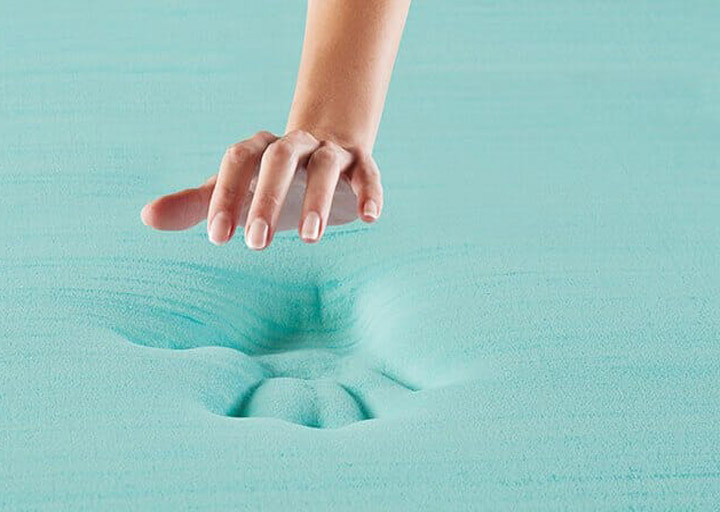
But if you’re the type of person who tosses and turns during the night, there are brands that use a more responsive version of memory foam that makes it easier to move around on. And some foam can be made firm and dense, which is ideal for those who need firm toppers. One example that we’ve tested is the Puffy Deluxe mattress topper, which is offered in a firm version. This topper feels very firm and dense because the foam doesn’t have much give.
More often than not, however, memory foam toppers are going to work better for back and side sleepers who need to soften their mattress and get some additional pressure relief.
Latex foam
Latex foam is a mostly natural material (there are some synthetic latex foams out there) made from the sap of rubber trees. It’ll feel springy and responsive and very easy to move around on. This type of foam can also add some additional comfort and pressure relief, but it won’t be as body contouring as traditional foam.
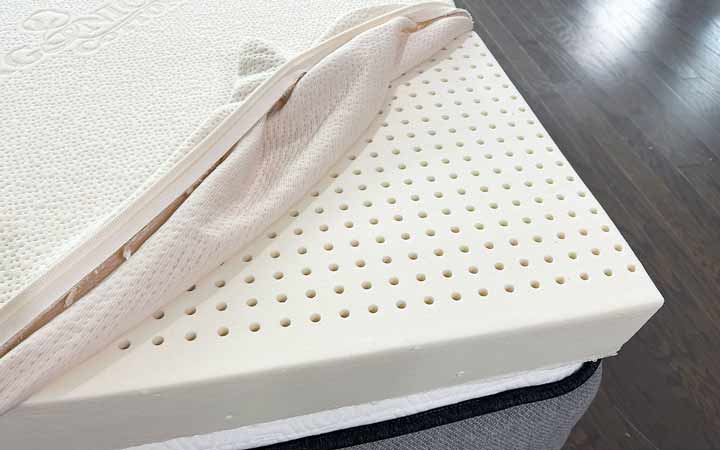
Latex is also a better choice for those who run hot. This material is super breathable and is often ventilated for improved airflow. Because you’re probably not going to sink too far into latex foam, you shouldn’t have your body heat reflected back at you either.
Just like traditional foam, latex foam toppers can come in a variety of firmness options.
Down
Down mattress toppers (also called featherbeds) are exactly what they sound like: a mix of down and feathers inside of a cover. These toppers will be fluffy and airy and will add a pillow top look and feel to the top of your mattress. They won’t offer as much pressure relief as foam, but if you love down in your pillows, featherbeds are essentially one giant down pillow.
They’re great at temperature regulation because down is a natural insulator. This means that the topper will be able to retain heat during cold months, but shouldn’t overheat during the warm months. However, down can sometimes trap allergens in your sleep environment, so these types of toppers may not be the best choice for those with sensitive allergies.
Down toppers don’t usually provide much support, putting them almost exclusively in the soft category.
Down Alternative
While it’s more common to see down alternative in mattress pads, there are some toppers that use down alternative fills to soften your mattress. This material feels soft, plush, and fluffy. Down alternative is a synthetic material, so these toppers tend to be a bit more affordable than natural down. However, they often don’t come with cooling infusions and might not be the best choice for hot sleepers.
Sleeping Position
Our initial tests involve moving around on a mattress topper to get a sense of its firmness and feel. But once we’ve done that, we take the time to settle into each sleeping position to better understand which positions will get what they need from the topper.
Back Sleepers
Typically back sleepers will want a soft to medium-firm mattress topper. Some mattresses might not have enough of a comfort layer to offer body contouring and pressure relief for back sleeping. When we test toppers on our back, we’re making sure that our hips aren’t sinking too far into the topper and that our lower back still feels supported.
Side Sleepers
Toppers are crucial for a side sleeper who’s not getting much, if any, pressure relief on their current mattress. Thick toppers that are soft or sometimes medium-firm are ideal here. When we test a topper on our side, we look for how much pressure relief the topper provides. If we recommend a topper for side sleepers, that means we felt little to no pressure build up on the topper at all.
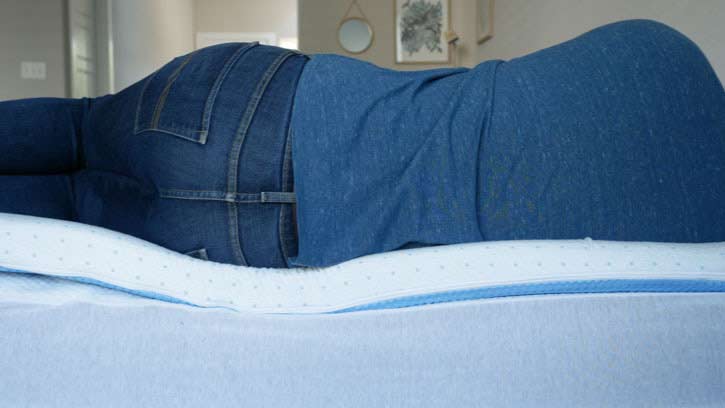
Stomach Sleepers
When we test mattress toppers (regardless of firmness) we pay close attention to our hips and whether or not they’re sinking too far into the topper. We don’t often recommend toppers for stomach sleepers. This is mainly because most people are looking at toppers to soften mattresses. But some stomach sleepers might be dealing with lower back pain from a mattress that’s too soft. If this is the case, a firm mattress topper could help. A firm topper may be able to support their hips enough to take some strain off of their lower backs.
RELATED: Best Mattress Toppers for Stomach Sleepers
Temperature Regulation & Cooling
When we assess mattress toppers for their cooling or temperature regulation properties, we’re on the lookout for a few different things. Here’s a quick list of features that tell us if a topper will be good for hot sleepers or not:
- Gel infused memory foam: This type of infusion will pull body heat away from you.
- Ventilated foam: This is seen in both latex and memory foam. The foam will be perforated with holes which allow for airflow.
- Cover materials: If a topper has a cover, chances are it’ll have some kind of cooling material worked into it. Some examples of this are:
- Bamboo fabric
- TENCEL fabric
- Phase change material (a kind of polyester that is designed to stay cool)
Our cooling tests usually involve laying on the mattress topper for, at a minimum, an hour to assess how much heat transfer we feel.
If our testers felt relatively comfortable, the topper usually scores about average to start. Then we take into consideration the cooling features, such as the ones listed above. Toppers that include these materials usually perform better and have higher scores than those without.
Fit
Toppers used to be just a slab of foam that you’d fit under the fitted sheet. While that’s still true of some products, modern toppers typically have covers that have straps which can help secure them to your mattress.
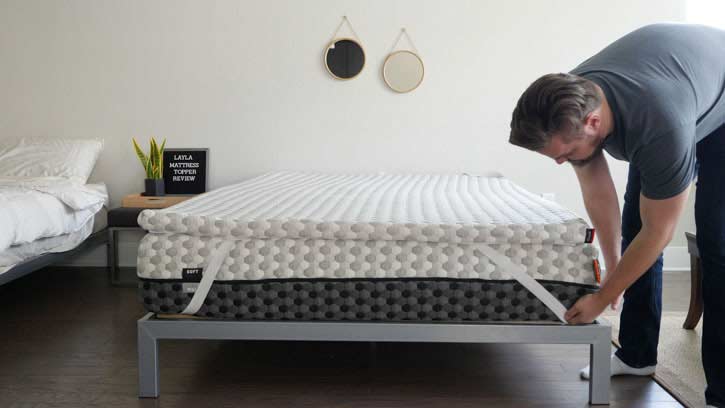
Our fit test usually consists of us placing the topper on the mattress and rolling around on it to see how well it stays in place. Toppers without a cover will be tested under a fitted sheet. If the topper shifts a lot, it will usually get a lower score. Toppers with covers tend to perform better than those without, and toppers with a cover that have corner straps almost always receive a perfect 5/5.
Durability
Mattress toppers aren’t really meant to be long term solutions, but knowing that they can add a couple more years of life to your mattress can be important. Durability is a long term test, and most of our testing is completed over the course of a handful of days. So, when we score for durability we’re using our expert knowledge of the materials, design, and care instructions of the topper to make an educated guess. We also look at the warranty, if the brand offers one, to help inform this score as well.
Toppers that get low scores on durability are usually simple in design or hard to clean. More often than not, this looks like a topper that’s a single piece of foam without a cover.
The toppers that tend to score closer to a 5/5 usually have an outer cover that can be removed and machine-washed. Latex is also an incredibly durable material. There are some latex toppers that come without covers, and those should last a while, too. But latex foam that comes inside of a cover tends to be the longest lasting kind of topper.
Mattress Topper Care
Care does play a role in the durability score. I touched on it briefly above, but if a topper has a machine-washable element to it, that usually helps bring the durability score up. Toppers that have covers you can’t remove typically have spot-clean instructions. This usually brings the score down, but not by a lot.
Other Considerations
These next two categories aren’t necessarily about the toppers performance, but they are worth mentioning as they are part of our testing process.
Body Type
Here at Mattress Clarity, our testers vary in body type, as does the rest of the world. When we test toppers, we take into consideration our own body weight and how that can change the way we experience the toppers. Firmness, feel, and height are all big pieces of the puzzle in helping us determine who the topper will be ideal for.
Soft, thin toppers will often work better for most lightweight (classified as under 130 lbs) back and side sleepers. Average-weight (130-230 lbs) back and side sleepers will want a topper that’s at least 3” tall and can find what they need on soft or medium-firm mattress toppers. Heavyweight individuals (over 230 lbs) generally need medium-firm toppers, but may want a thicker soft topper. This helps ensure they won’t “bottom out” of the topper.
RELATED: Best Mattress Toppers for Heavy People
Stomach sleepers will likely benefit from a firm surface that elevates their hips. For lightweight sleepers, this might look like a thin medium-firm or firm topper. Average- and heavyweight stomach sleepers will probably need firm toppers.
Off-Gassing
Toppers will often arrive on your door compressed into a cardboard box. In the case of foam toppers, this usually means the foam will need some time to expand once fully unpackaged. In the mattress industry, we call this “off-gassing.” Foam toppers will often need about an hour to fully expand, and, if they have a chemical smell, you might want to leave them in a ventilated area to fully off-gas. In our experience, this can last anywhere from 24 to 48 hours.
When Should I Get a Mattress Topper?
If you’re torn between getting a new mattress and getting a mattress topper, you’re not alone. But hopefully I can help clear things up. In my experience, toppers are necessary when one of two scenarios happen:
- You got a new bed and it’s not the way you thought it would feel or
- Your mattress is a handful of years old, but buying a new mattress is a little bit out of budget
In the first scenario, toppers can help out because you just bought a new mattress and are, for whatever reason, unable to return and get a refund. So, you turn to toppers to help find the firmness and feel in your mattress that you want.
In the second scenario, trying to find a good, high-quality mattress isn’t always cheap. So, if you’ve got a mattress that’s several years old, but not too old that you need to toss it out, toppers are a great option. Toppers are also a good, budget-friendly way to get a couple extra years out of your mattress before it’s time to fully replace.

